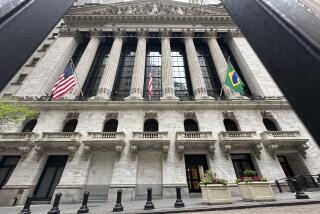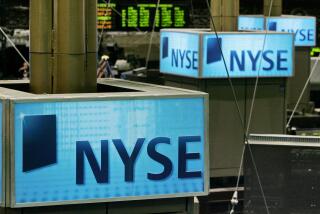In Earnings, Elements of Hope, Fear--Game Playing
- Share via
For all the anguish on Wall Street in July over corporate earnings, here’s the tally so far of second-quarter reports: 57% were above expectations, 16% were as expected and just 27% were below expectations.
So where’s the big profit problem that helped trigger the stock market’s slump last month?
That’s what Wall Street’s unrepentant bulls are asking. They say concerns about a sudden, devastating end to the corporate earnings boom of the last three years--a boom that has fueled stocks’ terrific rise--are so much bunk.
Yes, there is a slowdown in earnings growth occurring, says Jeffrey Applegate, investment strategist at brokerage Lehman Bros. in New York. But a collapse warranting a harrowing bear market? No way, he says.
Others aren’t so sanguine, even as last week’s slide in interest rates helped revive the bull market. Some experts say a worrisome deterioration in earnings is being masked as many companies--and the analysts who follow them--”manufacture” positive surprises. Moreover, if the economy is slowing, as last week’s government data seemed to suggest, the outlook for earnings can’t possibly be sunny, doubters argue.
The question of corporate profits cuts to the very heart of investing, of course. In the long run, nothing is more important in determining a stock’s price than the earnings underlying the stock and the rate at which investors expect those earnings to grow. Nobody invests hoping that their company loses money, after all--you invest for growth.
Indeed, the surge in stock prices over the last five years has been fueled in large part by gangbuster earnings growth, as U.S. companies have slashed costs and refocused their businesses, in the process sharply boosting profit margins.
Earnings of the blue-chip Standard & Poor’s 500 companies, expressed per share (as if the index itself was a stock), rocketed from $15.97 in the post-recession year of 1991 to $33.96 last year--up 113%.
In contrast, S&P; profits rose 57% in the five years ended in 1989, which, like the last five years, was a time of sustained economic growth.
But earnings gains have been so good now for so long that Wall Street is wary. For many or most firms, profits tend to be cyclical--there are boom and bust periods, depending not only on the trend in the economy as a whole but also on supply-and-demand factors affecting industries. Just recall last year’s profit boom, then bust, for many semiconductor companies, as computer chips quickly went from shortage to glut.
Could a bust be looming for a significant portion of American businesses? Lehman’s Applegate doesn’t think so. Absent an economic recession, he thinks S&P; 500 earnings will grow 9% this year and an additional 8.5% in 1997.
That’s clearly slower growth than companies, and investors, have been used to in recent years, Applegate allows. But it’s still growth, not the feared decline in earnings that would cause investors to lower prices they’re willing to pay for stocks, he says.
Key to Applegate’s forecast is that he expects many companies to do whatever it takes to preserve the high profit margins they have worked hard to achieve since 1991. The average industrial firm in the S&P; index earned 5.8 cents on every $1 of sales in 1995, up from 3.7 cents in 1992.
The 1995 margins were the highest since the mid-1960s, the glory days of U.S. manufacturing. “Can margins remain cyclically high like this? I think they can,” Applegate says. In fact, he sees the S&P; industrials’ average margin at 6.1% by year’s end.
But the “how” involved in that margin maintenance won’t make workers happy: “Companies will continue to be aggressive in managing labor costs,” Applegate says. Translation: more layoffs and related cost cutting, along the lines of recent such announcements from AlliedSignal, RJR Nabisco, ConAgra and Digital Equipment.
Despite substantial job creation in the economy as a whole this year, the ongoing substitution of capital (i.e., equipment) for labor at many of the blue-chip firms whose stocks dominate Wall Street is a major reason why those companies have repeatedly beat analysts’ earnings estimates since 1993, Applegate says--and why, on balance, they beat them again in the second quarter.
Yet the obsession with beating quarterly profit estimates is producing a false sense of security about earnings, some analysts argue. Greg Smith, investment strategist at Prudential Securities in New York, says that while 57% of companies may have beaten analysts’ estimates in the second quarter, “typically [they] are beating the estimates by very thin margins, commonly a penny or two per share.” That is not particularly encouraging, he says, especially considering how strong the U.S. economy was in the quarter.
More troubling is the assertion by Richard Bernstein, earnings tracker at Merrill Lynch in New York, that “we’re seeing more and more ‘manufactured’ earnings surprises.” A manufactured surprise, he says, occurs when a company guides analysts to lower their estimates for the quarter in the weeks leading up to the report, then announces a number that--voila!--beats those lower estimates.
Ben Zacks, whose firm Zacks Investment Research in Chicago tallies earnings results by quarter (that’s his 57% figure above) agrees that the estimate games being played are “egregious” nowadays.
He cites the example of a small tech company, which he declined to name, whose second-quarter profit estimate was cut to 7 cents a share by the analyst at the investment banker that brought the firm public six months ago. Surprise: The company reported earnings of 26 cents a share. “If the investment banker doesn’t know what that company’s going to do, who does?” Zacks asks.
But is the market fooled by such games? Apparently not. Despite seemingly robust second-quarter earnings data, the stock market was slammed in July, in the deepest pullback since 1994. It was only bailed out last week when interest rates began to decline again.
The problem with falling interest rates, Bernstein notes, is that they confirm that the economy is slowing, which will only make it tougher for many companies to show ever-higher earnings, especially given rising labor costs.
There are plenty of individual company exceptions, Bernstein allows, but in general “profit growth is becoming more scarce,” he warns. And as stocks’ plunge in July showed, when investors fear that the overall profit trend is turning, they often throw most stocks out, figuring to sort out the true earnings winners later.
(BEGIN TEXT OF INFOBOX / INFOGRAPHIC)
Earnings Explosion
The blue-chip companies in the Standard & Poor’s 500-stock index have produced spectacular earnings gains over the last three years, thanks in part to extraordinary restructuring and cost-cutting efforts. Annual earnings of the S&P; companies expressed as a per-share figure based on the index.
Note: Results are final reported date, after any one-time write-offs.
Source: Standard & Poor’s
More to Read
Inside the business of entertainment
The Wide Shot brings you news, analysis and insights on everything from streaming wars to production — and what it all means for the future.
You may occasionally receive promotional content from the Los Angeles Times.










